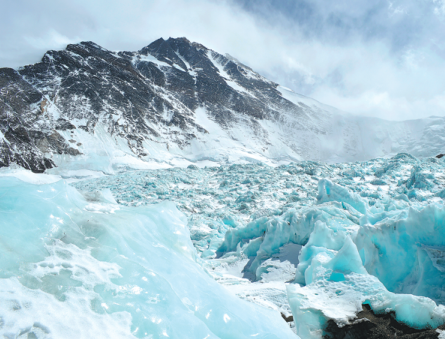Chinese scientists race against time to save glaciers

LANZHOU — Chinese scientists are in "a race against time" to mitigate glacier melting by employing innovative technologies such as artificial snow enhancement, nanomaterials coverage and other scientific explorations.
Recently, two rounds of artificial snow operations were conducted in the Bailang River glacier area in Northwest China's Qilian Mountains. These operations utilized a variety of artificial snow facilities, including aircraft, rockets, and weather modification burners.
A research team from the Chinese Academy of Sciences collaborated with the provincial meteorological bureau of Gansu to implement these operations, aiming to reduce glacier retreat and increase snow and ice accumulation.
"Protecting glaciers is a long-term and arduous task. We are in a race against time," said Kang Shichang, a glacier expert at the Institute of Mountain Hazards and Environment of the CAS and leader of the research team.
Artificial snow enhancement in alpine areas during spring can increase glacial mass accumulation. It can also enhance the glacier surface albedo, reducing solar radiation absorption and thereby slowing down the melt rate, according to Du Wentao, a researcher at the CAS Northwest Institute of Eco-Environment and Resources and a member of the research team.
"This approach can benefit hydrology, ecology, agriculture and other critical fields. Thus, it can play a role in glacier conservation at both watershed and mountain range scales," Du said.
Glaciers are an important part of the Earth's freshwater resources, providing drinking water and irrigation water for billions of people around the world. They have also been pivotal in regulating global climate and maintaining biodiversity.
As the climate warms, glaciers around the world are melting at an alarming rate. According to the latest study published in the journal Nature, from 2000 to 2023, glaciers have lost about 5 percent of their ice mass globally. Meanwhile, the rate at which glaciers are melting continues to accelerate.
There are about 69,000 glaciers in China covering approximately 46,000 square kilometers, as highlighted by the third Chinese glacier inventory released in March.
Compared with the second inventory, the overall glacier area in China decreased by nearly 6 percent over the 2008-2020 period.
The melting of glaciers can trigger a water crisis and accelerate a rise in sea levels. Continuous glacier retreat will also lead to their own structural instability, making glaciers more sensitive to external influences while amplifying the frequency and intensity of glacier-related disasters and secondary disaster chains, according to Kang.
The scientific protection of glaciers, along with advancements in glacier research, has garnered widespread consensus among governments, academia and the public. In China, diverse scientific explorations, aside from artificial snow enhancement, are actively underway.
Researchers are deploying experimental "giant blankets", made of nanometer materials, geotechnical fabrics and other advanced materials, over selected sites, such as the Dagu Glacier in Southwest China's Sichuan province and the Urumqi Glacier No. 1 in Northwest China's Xinjiang Uygur autonomous region, to decelerate rapid ice loss.
Du emphasized that artificial snow enhancement can effectively protect glaciers under the current greenhouse gas emission levels.
He said the research team will strengthen cooperation with the meteorological authorities this year to optimize the implementation plan and evaluation method of artificial snow enhancement in high mountain areas. They will also enhance the protection efficacy and expand the scope of coverage.
"Our researchers will also actively introduce novel methods and continue to enhance glacier monitoring research to obtain more accurate data and lay the foundation for scientific glacier conservation," Du added.
Xinhua


Today's Top News
- Beijing calls for genuine Mideast truce
- China to hold military parade on Victory Day
- Ceasefire must not be delayed-action bomb
- Experts, execs express confidence in Chinese economy
- China calls for justice, fairness in Middle East
- 'Ceasefire' a watershed of Middle East geopolitics






























